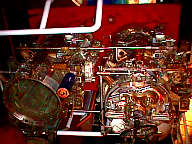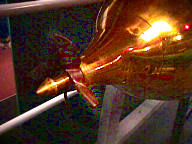The one I selected was DID YOU KNOW -- The speed of sound
in water is roughly one mile a second - slower than through land but faster than
through air. The speed of sound varies depending on water temperatures
salinity and depth. In order to track objects accurately, the speed of
sound (in water) must be known. There is actually a formula for it which
reads like this ( c=1449 + 4.6T - 0.055T+0.0003T +
(1.39-0.012T)(s-35)+0.017d) where c = the speed of sound in meters per second, T
= the temperature of seawater in centigrade, s = the salinity expressed in parts
per thousand and of course d = the  depth
below the surface in meters. Now don't you feel enlightened? The main attraction
in the center of the room were the two starboard torpedo tubes from the fleet
ballistic missile submarine USS Tecumseh (SSBN 628). A similar pair was on the
port side. Tecumseh was commissioned in 1964 and decommissioned in '93.
Torpedo tubes are complex, heavy-duty machines which must safely fire a two-ton
torpedo through the hull of the ship at deep depths, prevent water from entering
the torpedo
depth
below the surface in meters. Now don't you feel enlightened? The main attraction
in the center of the room were the two starboard torpedo tubes from the fleet
ballistic missile submarine USS Tecumseh (SSBN 628). A similar pair was on the
port side. Tecumseh was commissioned in 1964 and decommissioned in '93.
Torpedo tubes are complex, heavy-duty machines which must safely fire a two-ton
torpedo through the hull of the ship at deep depths, prevent water from entering
the torpedo  room,
and minimize noise and the escape of air after firing. Complex interlocks
ensure crew and ship safety. The torpedo turned out to be a fascinating
creation of both complexity and simplicity. The Mk 18 was the first successful
electric torpedo developed in the US. Westinghouse Electronic Company
designed and built it using a captured German G7 torpedo as a model, in 1942.
It was developed in only 15 weeks and had many flaws when it arrived in Pearl
Harbor. Although untested, most Sub commanders were so disgusted with the
Mk 14 that they tried to make the Mk 18 work. This time feedback was good
and changes came quickly . By the end of the War 65% of all U-boats were
using the Mk 18 and over a million tons of Japanese shipping was sent to the
bottom of the ocean, from its use. Early in World War II, submarine commanders
began reporting torpedoes performance problems. Some were detonating
early, while others were not detonating at
room,
and minimize noise and the escape of air after firing. Complex interlocks
ensure crew and ship safety. The torpedo turned out to be a fascinating
creation of both complexity and simplicity. The Mk 18 was the first successful
electric torpedo developed in the US. Westinghouse Electronic Company
designed and built it using a captured German G7 torpedo as a model, in 1942.
It was developed in only 15 weeks and had many flaws when it arrived in Pearl
Harbor. Although untested, most Sub commanders were so disgusted with the
Mk 14 that they tried to make the Mk 18 work. This time feedback was good
and changes came quickly . By the end of the War 65% of all U-boats were
using the Mk 18 and over a million tons of Japanese shipping was sent to the
bottom of the ocean, from its use. Early in World War II, submarine commanders
began reporting torpedoes performance problems. Some were detonating
early, while others were not detonating at all. The Navy, eager to make a showing in the Pacific, was reluctant to
accept the commanders reports. An investigation was finally launched and it was determined that
the weapons did in fact fail on numerous occasions and that insufficient testing
allowed the problem to exist. This boosted the importance of the
Keyport testing range significantly. The Mk 18's lead -acid batteries
(similar to the ones in cars) produced 151-155 volts, supplied to a 90 HP direct
current motor. These batteries had to be "topped-off" or given a
charge, from time to time to ensure that they would provide peak current when
fired. The handholds in the top of the battery compartment gave torpedomen
access to the batteries, so they could measure the specific gravity of the
electrolyte (diluted sulfuric acid), add water and vent any hydrogen gas
generated during battery charge. There were several intriguing artifacts
associated with the various torpedoes. As the art of undersea
all. The Navy, eager to make a showing in the Pacific, was reluctant to
accept the commanders reports. An investigation was finally launched and it was determined that
the weapons did in fact fail on numerous occasions and that insufficient testing
allowed the problem to exist. This boosted the importance of the
Keyport testing range significantly. The Mk 18's lead -acid batteries
(similar to the ones in cars) produced 151-155 volts, supplied to a 90 HP direct
current motor. These batteries had to be "topped-off" or given a
charge, from time to time to ensure that they would provide peak current when
fired. The handholds in the top of the battery compartment gave torpedomen
access to the batteries, so they could measure the specific gravity of the
electrolyte (diluted sulfuric acid), add water and vent any hydrogen gas
generated during battery charge. There were several intriguing artifacts
associated with the various torpedoes. As the art of undersea  war
advanced, major concerns arose for the safety of the men who had to operate the
submarines and handle the highly explosive torpedoes. An over-simplified
description of a torpedo is a motor, pushing an explosive through the
water, tipped with a firing pin. The relationship between the explosive and the
(trigger) firing pin has been and always will be a delicate relationship. When
in close proximity to each other, very destructive things happened. So, the rule
of thumb became and still remains, to keep the two physically separated until the last
second required to fulfill the mission. Torpedoes were
war
advanced, major concerns arose for the safety of the men who had to operate the
submarines and handle the highly explosive torpedoes. An over-simplified
description of a torpedo is a motor, pushing an explosive through the
water, tipped with a firing pin. The relationship between the explosive and the
(trigger) firing pin has been and always will be a delicate relationship. When
in close proximity to each other, very destructive things happened. So, the rule
of thumb became and still remains, to keep the two physically separated until the last
second required to fulfill the mission. Torpedoes were  designed
as very big bombs. Until the creations of proximity detonators, detonation
occurred on contact with a solid object, which normally happened by slamming the
nose of the torpedo into the side of a ship. The very tip of the torpedo was not
too different from an old rifle firing pin. When struck, it slammed into a
primer which ignited the explosive head. The challenge was to not strike
the firing pin while moving the torpedo around in the submarine. This brought me
to the invention which confused me when I saw my first Mk torpedo.
It had a propeller at both ends. Although I'm not overly informed about
these things I had never heard of a torpedo backing up. Looking at the cut-away
section of the firing mechanism in the nose of the torpedo and reading the
detailed placard, I found out how they made the torpedo safe right up to the
last few seconds. The firing pin was designed to be screwed in tight
against the primer. However, it was always maintained in a screwed out position.
In this position all the pounding in the world would not force the firing pin
into the primer. It was simply screwed out too far. Once the torpedo
sped through the water, the propeller on the front began to spin and in doing so
screwed the firing pin down against the primer and the torpedo was ready to
explode on first contact. With a little engineering, the exact point a torpedo
would reach, away from the submarine, before the firing pin was seated, could be
established. Thus, a new expression was entered into the English vocabulary,
"arming time". It has become a common tern for those who deal in
bombs, missiles, and of course torpedoes. It would seem to be the ultimate
offense, but wait! It too has a weak point. When attacked by a
submarine, if you can get your vessel closer to the submarine than the distance
required of its torpedo's "arming time", it will simply bounce off the side of
your ship. Sure! Well, it is one of the tactical
exercises offered in the defense manuals. What can I say? I loved the
place. It's on the "must see" for all the Navy buffs.
designed
as very big bombs. Until the creations of proximity detonators, detonation
occurred on contact with a solid object, which normally happened by slamming the
nose of the torpedo into the side of a ship. The very tip of the torpedo was not
too different from an old rifle firing pin. When struck, it slammed into a
primer which ignited the explosive head. The challenge was to not strike
the firing pin while moving the torpedo around in the submarine. This brought me
to the invention which confused me when I saw my first Mk torpedo.
It had a propeller at both ends. Although I'm not overly informed about
these things I had never heard of a torpedo backing up. Looking at the cut-away
section of the firing mechanism in the nose of the torpedo and reading the
detailed placard, I found out how they made the torpedo safe right up to the
last few seconds. The firing pin was designed to be screwed in tight
against the primer. However, it was always maintained in a screwed out position.
In this position all the pounding in the world would not force the firing pin
into the primer. It was simply screwed out too far. Once the torpedo
sped through the water, the propeller on the front began to spin and in doing so
screwed the firing pin down against the primer and the torpedo was ready to
explode on first contact. With a little engineering, the exact point a torpedo
would reach, away from the submarine, before the firing pin was seated, could be
established. Thus, a new expression was entered into the English vocabulary,
"arming time". It has become a common tern for those who deal in
bombs, missiles, and of course torpedoes. It would seem to be the ultimate
offense, but wait! It too has a weak point. When attacked by a
submarine, if you can get your vessel closer to the submarine than the distance
required of its torpedo's "arming time", it will simply bounce off the side of
your ship. Sure! Well, it is one of the tactical
exercises offered in the defense manuals. What can I say? I loved the
place. It's on the "must see" for all the Navy buffs.
*** THE END ***
